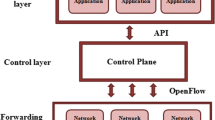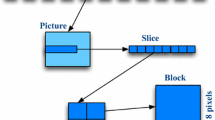Abstract
At present, 5G has become the upcoming generation of wireless communication systems. The 5G network intends to offer the users with higher data transfer rates along with low latency in addition, and it also affords highly meaningful and adapted services regarding the users together with their knowledge about the services desired. In recent days, the role of video streaming services (VSSs) has turned into a significant part of human’s daily life. Nevertheless, the previous video streaming applications and services (VASs) developments are typically in the long-term evolution network (LTE) along with wireless network (WN). And in the 5G network, certain articles study the VSS quality analysis methodology. The quality of experience (QoE) structure meant for video services in the 5G network is being surveyed in this research. After that, the HTTP adaptive streaming (HAS) solution is being discussed, which is considered as the leading methodology for streaming videos in the 5G networks. Next to that, in software defined networking (SDN)/network functions virtualization (NFV), the major components are summarized in addition, the current projects, standardization actions, the use cases pertained to SDN/NFV, together with other rising applications are outlined. The QoE framework’s complications along with possibilities in 5G are also illustrated in this research work.
Access this chapter
Tax calculation will be finalised at checkout
Purchases are for personal use only
Similar content being viewed by others
References
Yang M, Wang S, Calheiros R, Yang F (2018) Survey on QoE assessment approach for network service. IEEE Access 6:48374–48390. https://doi.org/10.1109/ACCESS.2018.2867253
Philip NY, Rehman IU (2016) Towards 5G health for medical video streaming over small cell. Int Federation Med Biol Eng 57:1093–1098. https://doi.org/10.1007/978-3-319-32703-7_215
Tsolkas D, Liotou E, Passas N, Merakos L (2017) A survey on parametric QoE estimation for popular services. J Netw Comput Appl 77:1–17. https://doi.org/10.1016/j.jnca.2016.10.016
Hou Y, Song L, Gao M (2016) A QoE estimation model for video streaming over 5G millimeter wave network. Adv Broad-Band Wirel Comput Commun Appl 93–104. https://doi.org/10.1007/978-3-319-49106-6_9
Huang W, Zhou Y, Xie X, Wu D, Chen M, Ngai E (2018) Buffer state is enough: simplifying the design of QoE-aware HTTP adaptive video streaming. IEEE Trans Broadcast 64(2):590–601. https://doi.org/10.1109/TBC.2018.2789580
Li C, Toni L, Zou J, Xiong H, Frossard P (2017) QoE-driven mobile edge caching placement for adaptive video streaming. IEEE Trans Multimed 20(4):965–984. https://doi.org/10.1109/TMM.2017.2757761
Nightingale J, Wang Q, Alcaraz Calero JM, Chirivella-Perez E, Ulbricht M, Alonso-López JA, Preto R et al (2016) QoE-driven, energy-aware video adaptation in 5g networks: the selfnet self-optimisation use case. Int J Distributed Sens Netw 1–15. https://doi.org/10.1155/2016.7829305
Liotou E, Samdanis K, Pateromichelakis E, Passas N, Merakos L (2018) QoE-SDN APP: a rate-guided QoE-aware SDN-APP for HTTP adaptive video streaming. IEEE J Sel Areas Commun 36(3):598–615. https://doi.org/10.1109/JSAC.2018.2815421
Canovas A, Rego A, Romero O, Lloret J (2020) A robust multimedia traffic SDN-Based management system using patterns and models of QoE estimation with BRNN. J Netw Comput Appl 150:1–18. https://doi.org/10.1016/j.jnca.2019.102498
Kourtis M-A, Koumaras H, Xilouris G, Liberal F (2017) An NFV-based video quality assessment method over 5G small cell networks. IEEE MultiMed 24(4):68–78. https://doi.org/10.1109/MMUL.2017.265091534
Chen X, Zhao Y, Li Y (2019) QoE-aware wireless video communications for emotion-aware intelligent systems: a multi-layered collaboration approach. Inf Fusion 47:1–9. https://doi.org/10.1016/j.inffus.2018.06.007
Nightingale J, Salva-Garcia P, Alcaraz Calero JM, Wang Q (2018) 5G-QoE: QoE modelling for ultra-HD video streaming in 5G networks. IEEE Trans Broadcast 64(2):621–634. https://doi.org/10.1109/TBC.2018.2816786
Salva-Garcia P, Alcaraz-Calero JM, Alaez RM, Chirivella-Perez E, Nightingale J, Wang Q (2018) 5G-UHD: design, prototyping and empirical evaluation of adaptive ultra-high-definition video streaming based on scalable h. 265 in virtualised 5g networks. Comput Commun 118:171–184. https://doi.org/10.1016/j.comcom.2017.11.007
Sharma V, You I, Kumar R (2018) Resource-based mobility management for video users in 5G using catalytic computing. Comput Commun 118:120–139. https://doi.org/10.1016/j.comcom.2017.10.009
Yu Y-J, Pang A-C, Yeh M-Y (2018) Video encoding adaptation for QoE maximization over 5G cellular networks. J Netw Comput Appl 114:98–107. https://doi.org/10.1016/j.jnca.2018.04.008
Guo B, Zhang X, Wang Y, Yang H (2019) Deep-q-network-based multimedia multi-service qos optimization for mobile edge computing systems. IEEE Access 7: 60961–160972. https://doi.org/10.1109/ACCESS.2019.2951219
Du L, Zhuo L, Li J, Zhang J, Li X, Zhang H (2020) Video quality of experience metric for dynamic adaptive streaming services using dash standard and deep spatial-temporal representation of video. Appl Sci 10(5):1–15. https://doi.org/10.3390/app10051793
Martin A, Egaña J, Flórez J, Montalbán J, Olaizola IG, Quartulli M, Viola R, Zorrilla M (2018) Network resource allocation system for QoE-aware delivery of media services in 5G networks. IEEE Trans Broadcast 64(2):561–574. https://doi.org/10.1109/TBC.2018.2828608
Sun G, Ayepah-Mensah D, Xu R, Boateng GO, Liu G (2020) End-to-end CNN-based dueling deep Q-network for autonomous cell activation in cloud-RANs. J Netw Comput Appl 169:1–12. https://doi.org/10.1016/j.jnca.2020.102757
Bega D, Gramaglia M, Fiore M, Banchs A, Costa-Perez X (2019) DeepCog: cognitive network management in sliced 5g networks with deep learning. In: IEEE INFOCOM 2019-IEEE conference on computer communications, IEEE. https://doi.org/10.1109/INFOCOM.2019.8737488
Na W, Bae B, Cho S, Kim N (2019) DL-TCP deep learning-based transmission control protocol for disaster 5g mm wave networks. IEEE Access 7:145134–145144. https://doi.org/10.1109/ACCESS.2019.2945582
Shi Y, Feng D, Biswas S (2019) A natural language-inspired multi-label video streaming traffic classification method based on deep neural networks. Signal Image Video Process. https://doi.org/10.1007/s11760-020-01844-8
Alawe I, Ksentini A, Hadjadj-Aoul Y, Bertin P (2018) Improving traffic forecasting for 5G core network scalability: a machine learning approach. IEEE Network 32(6):42–49. https://doi.org/10.1109/MNET.2018.1800104
Vega MT, Mocanu DC, Liotta A (2017) Unsupervised deep learning for real-time assessment of video streaming services. Multimed Tools Appl 76:22303–22327. https://doi.org/10.1007/s11042-017-4831-6
Mustafa RU, Ferlin S, Rothenberg CE, Raca D, Quinlan JJ (2020) A supervised machine learning approach for dash video qoe prediction in 5g networks. In: Proceedings of the 16th ACM symposium on QoS and security for wireless and mobile networks, July 2017, Washington. https://doi.org/10.1145/3416013.3426458
Ramezanpour K, Jagannath J (2021) Intelligent zero trust architecture for 5g/6g tactical networks: principles, challenges, and the role of machine learning. https://arxiv.org/abs/2105.01478
Petrangeli S, Wu T, Wauters T, Huysegems R, Bostoen T, Turck FD (2017) A machine learning-based framework for preventing video freezes in HTTP adaptive streaming. J Netw Comput Appl 94:78–92. https://doi.org/10.1016/j.jnca.2017.07.009
Schwarzmann S, Marquezan CC, Trivisonno R, Nakajima S, Zinner T (2020) Accuracy versus cost trade-off for machine learning based QoE estimation in 5G networks. In: ICC 2020–2020 IEEE international conference on communications (ICC). IEEE, pp 1–6, 7–11 June 2020, Dublin, Ireland. https://doi.org/10.1109/ICC40277.2020.9148685
Author information
Authors and Affiliations
Corresponding author
Editor information
Editors and Affiliations
Rights and permissions
Copyright information
© 2023 The Author(s), under exclusive license to Springer Nature Singapore Pte Ltd.
About this paper
Cite this paper
Ajeyprasaath, K.B., Vetrivelan, P., Chang, E., Gomathi, S. (2023). A Survey of QoE Framework for Video Services in 5G Networks. In: Subhashini, N., Ezra, M.A.G., Liaw, SK. (eds) Futuristic Communication and Network Technologies. Lecture Notes in Electrical Engineering, vol 966. Springer, Singapore. https://doi.org/10.1007/978-981-19-8338-2_45
Download citation
DOI: https://doi.org/10.1007/978-981-19-8338-2_45
Published:
Publisher Name: Springer, Singapore
Print ISBN: 978-981-19-8337-5
Online ISBN: 978-981-19-8338-2
eBook Packages: EngineeringEngineering (R0)




